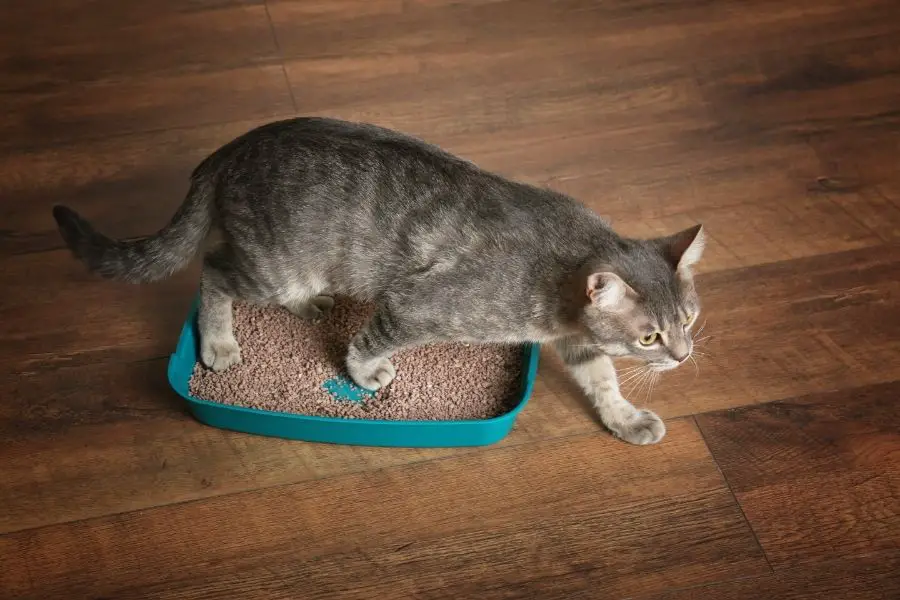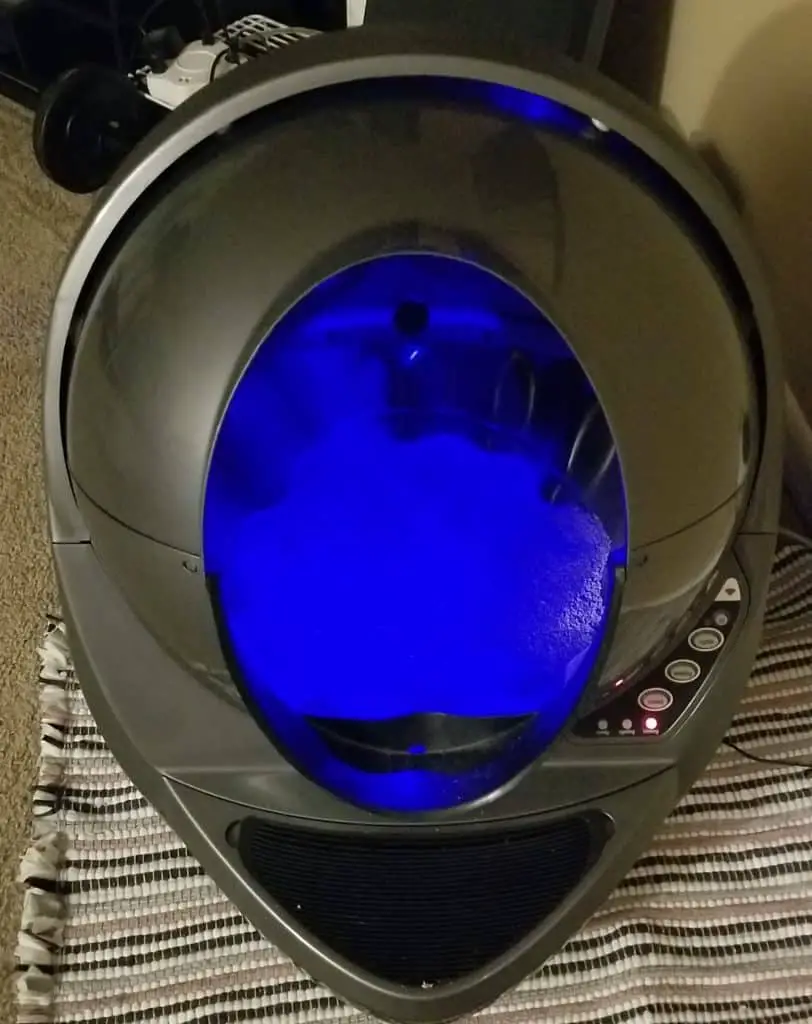More Meows is an Amazon Associate. As an Amazon Associate we earn from qualifying purchases. We may also earn commissions if you purchase products from other retailers after clicking on a link from our site.
Litter training a cat is essential to cat ownership for most people. A litter-trained cat is easier to care for, and a clean litter box keeps the home more healthy, hygienic, and pleasant smelling. However, beginning litter training can feel daunting for most. Some cats take to the litter box right away, and others take more training.
Cats are not hard to litter train if they are taught early. A kitten will copy its mother cat and begin using the litter box very early. Training a kitten on its own will require more attention and loving reinforcement from the owner.
New cat owners training a young kitten must be patient and attentive to help the kitten litter train. This process may take a little while, and there will be accidents along the way.
An older cat who has been defecating outside will be harder to litter train. Likewise, a cat suffering from urinary tract issues will be hard to train until it receives the medical care necessary to regain health and go comfortably in the litter. Read on to learn more about cats and their litter training!
If you are wondering what the best products are for your cat, check out this article that will break down all my recommendations for you: Things To Buy For A Cat Right Now!
Steps For Litter Training a Kitten
While the circumstances around litter training a kitten will be different for each kitten, the principles and steps are the same.
- Choose the right location for the litter box. Owners often want to tuck the litter box away in a discreet place so that they do not have to see or smell the litter box. This can be done, but not until the kitten is very well trained to use the litter box. So instead, place the litter box where the kitten chooses to go potty.
- Choose more than one location. The odds are that your kitten wants to pee in more than one place. Choose at least two quiet locations where the kitten leaves messes, and place clean litter trays in those areas.
- Watch for signs that the kitten needs to use the litter box. For example, if you have placed the litter box or tray where the kitten always wants to go, they might got next to the new tray. If the kitten chooses a new place to go, then place another litter tray in that location.
- Place the kitten in the litter when it has the urge to go. This part of the training works by association. Help the kitten associate the desire to go with the feeling of going in the litter. This requires attentiveness and patience on your part. How many times you need to do this will depend on your kitten.
- Keep the litter perfectly clean. This means scooping it out every time the kitten goes. Kittens are notoriously clean and picky. You may sabotage your training efforts by letting the litter box get dirty. This dirty litter makes the kitten want to go elsewhere.
- Reward good behavior. Be generous with your praise, cuddles, and kitty treats during litter training. However, never hit or scold your kitten for not doing it right or going in the wrong area. This will cause the kitten to associate potty time with pain and look for more private places to do its business, which you are trying to avoid.
- If the kitten has an accident, clean it up immediately and thoroughly. The kitten will smell the urine and want to pee in the same place. Do not yell or hit the kitten, as this will make the kitten lose trust in you and make the training process harder.
- If the kitten continues going in the wrong place, put another litter box in it and encourage the kitten to go in it.

Choosing the Right Litter Box
There are many different styles of kitty litter boxes. You may discover that your cat will not go in a particular type of litter box or tray. Before you head to the pet superstore to pick out your dream litter box, look at the area where the cat has chosen to go. Analyze it from a cat’s perspective.
- If you have adopted a tiny kitten that has been primarily in a box on some towels, then you might start with an uncovered litter box with high sides and a shallow front that it can quickly get into.
- If your cat has been going outside for years, then choose a low-sided litter tray to get it used to going inside.
- If your cat tunnels to the back of a closet and goes in the corner, purchase a covered litter box with a small door.
Those are just a few examples of how you should analyze your cat’s behavior before buying a litter box. However, this is no guarantee that your feline will take to the box right away. Be patient and be willing to try a few different box and tray styles if your cat shows a reluctance to go inside the box.
I’ve tried a few different litter boxes with my cat. Above, I talked about the likely best litter box for a kitten. But, if your cat is older, you might want to consider an automatic litter box.
If you want an automatic litter box that is more affordable, you should check out this automatic litter box on Amazon (affiliate link): Click Here for More Affordable Automatic Litter Box on Amazon.

The litter box that I currently love for my cat (and that she adopted early and loves as well) is this automatic litter box that does everything right. It is pricey but has minimal human interaction and an app too. Check out the Litter-Robot 3 Connect on Amazon (affiliate link): Check Out The Litter-Robot 3 Connect on Amazon.
Choosing the Right Cat Litter
These days you can choose from a dizzying array of cat litters. From color-changing litters that tell you when to take your cat to the vet to plant-based pellets, silica-gel crystals, and natural clay-based litters, you have more selection now than ever.
Still, your cat may have its own opinion on which type of litter or pellet it likes best when it’s time to use the box.
- The best kind of litter to begin training a kitten is non-clumping clay or sand. This style of cat litter best stimulates a cat’s natural interest in digging.
- If your cat seems to be offended by the feeling of the litter that you choose, then try a different one. It can take some trial and error to find the right combination of litter box and litter that the cat likes to use.
- Some cats do not like scented litter. While these are designed to help your house smell fresher, the aroma may discourage the cat from digging in the litter.
- Clumping litters make cleaning the litter box easier for you so that you can keep it clean and fresh for your cat. In addition, this encourages the cat to continue using the container because it will not encounter its own waste as it digs for a new spot to use.
- The texture of plant-based and biodegradable litters and pellets may be more challenging to get the cat to use, but if you feel better about using them, then certainly give them a try.
I use two different cat litters regularly, and I feel comfortable recommending both of them. I use both about 50/50, and to be honest, I don’t have a favorite between the two of them.
I like Dr. Elsey’s Ultra Premium Clumping Cat Litter. It clumps quite well, and my cat likes it just fine. Check it out on Amazon (Affiliate link): Check Out This Great Clumping Litter on Amazon.
I also like Fresh Step Clumping Cat Litter. I feel like it masks any smells the best and still clumps well. Check out this cat litter on Amazon (affiliate link): Click Here to See Fresh Step Cat Litter on Amazon.
Medical Conditions That Make Litter Training Harder
If you are having a very difficult time litter training your cat, then there may be an underlying health condition that the cat is struggling with that makes it hard or uncomfortable to use the litter box. For example, a cat that is in pain will not be able to focus on pleasing you and learning to use the litter box.
- A urinary tract infection can make it very painful for that cat to urinate. As a result, the cat may go inside and urinate very little or not at all before leaving the box. The cat may also make sounds of discomfort when attempting to go.
- A cat with kidney stones is in a lot of pain. The cat may cry when attempting to use the litter box and also will show signs of pain when being touched, especially on the belly.
- Feline cystitis increases both the urge to urinate and the pain during urination. This means that your cat may suddenly begin trying to urinate in random places because he can not wait to get to the litter box. There also may be blood in the urine.
All of these instances call for an immediate visit to the vet. In the case of cystitis, the problem is life-threatening. Delaying care may cause the death of your cat.
In any case, signs of discomfort must be investigated by your veterinarian at soon as possible. You may want to take your cat for a vet checkup before you begin litter training to make sure that none of these problems are present before you start. This is especially important if you have adopted a feral cat or bring an outside cat to live inside the house.
Conclusion
Whether you are training an older cat or a new kitten, the strategy is the same. Of course, a kitten will be easier and faster to train than an older cat, but any cat can learn to use a litter box over time and with patient training.
Take your new cat for a vet checkup before you begin litter training. The vet will identify any intestinal illnesses, bacterial infections, or diseases that may be present that will make litter training harder. This will help litter box training to go as smoothly as possible.
I hope this article has helped teach a cat to use a litter box, pick the right litter, and some of the related medical conditions. If you enjoyed this article, please check a few more:
- Do Cats Like Cat Strollers? (The Honest Truth): Click Here
- Do Cats Like Cat Condos: Click Here.
- Are Cat Harnesses Cruel? (Complete Analysis): Click Here.
